Confused about what size trampoline to buy for your family?
This guide will help you navigate through the various trampoline sizes to find the perfect fit for your yard and your jumping crew.
From mini trampolines for toddlers to extra-large versions for gymnasts in the making, we’ve got you covered.
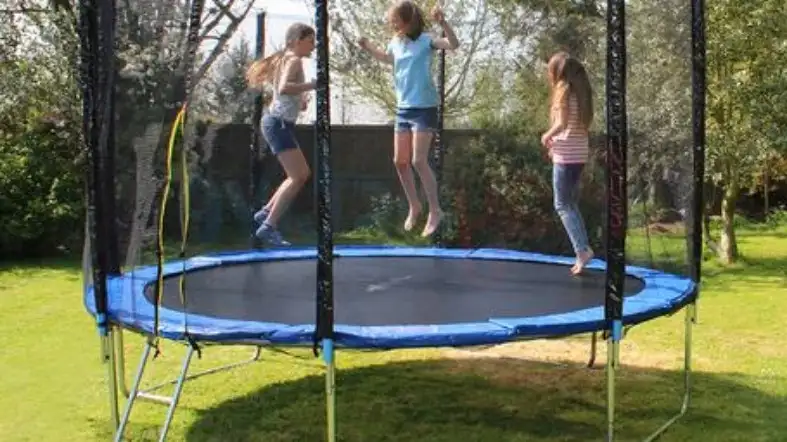
What Size Trampoline Should I Get?
For a small yard or 1-2 young children, a mini (3-5 feet) or small trampoline (8-10 feet) is suitable. For families with older kids and a medium-sized yard, a medium-sized trampoline (12-14 feet) is best. For larger families or yards, consider a large (15-17 feet) or extra-large trampoline (18-25 feet).
How to Determine the Right Size for Your Space?
Here are some steps to help you determine the right size for your space:
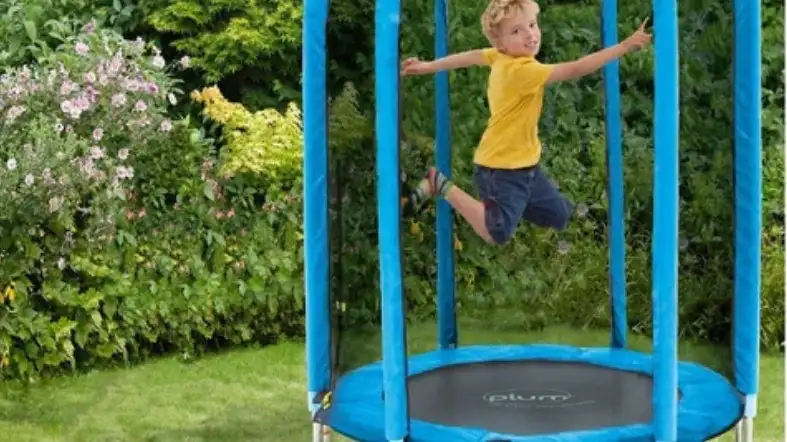
Measuring Your Yard
The first step is to measure your yard and find out how much space you have available for the trampoline. You can use a tape measure, a ruler, or a measuring app on your phone to do this.
You need to measure the length and width of your yard, as well as the height of any fences, walls, or trees around it.
Taking Note of Obstacles
The second step is to take note of any obstacles or hazards that may interfere with the trampoline. These include power lines, branches, roofs, windows, rocks, plants, furniture, toys, etc.
You need to make sure there is enough clearance between the trampoline and these obstacles to avoid any accidents or damages.
Considering Safety Clearances
The third step is to consider the safety clearances that are recommended for the trampoline.
These are the minimum distances that you need to leave around the trampoline for safety reasons.
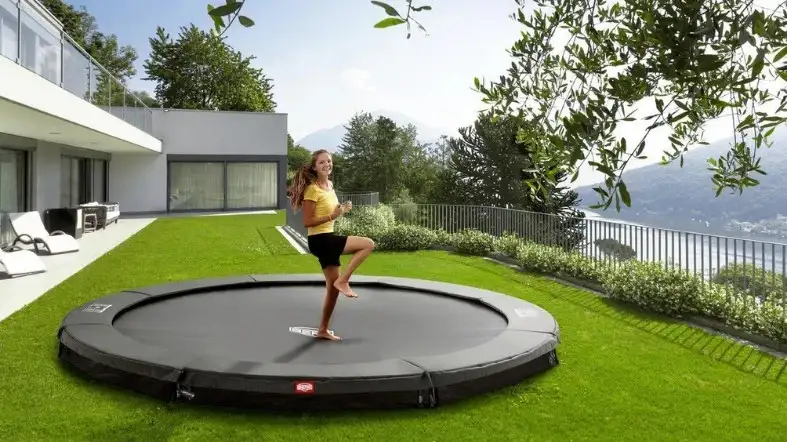
According to the American Society for Testing and Materials (ASTM), these are the safety clearances for different trampoline sizes:
| Trampoline Size | Diameter | Safety Clearance |
|---|---|---|
| Mini | 3-5 feet | 2 feet |
| Small | 8-10 feet | 6 feet |
| Medium | 12-14 feet | 8 feet |
| Large | 15-17 feet | 10 feet |
User-Specific Needs and Trampoline Sizes
Here are some examples of user-specific needs and how they affect the trampoline size:
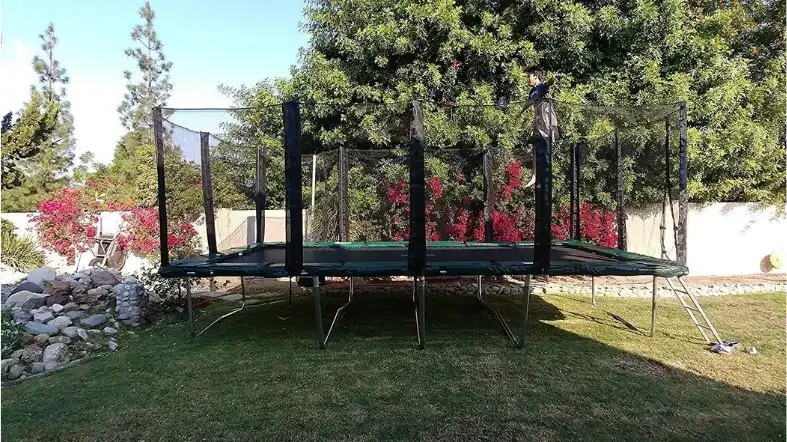
Trampolines for Kids
If you are buying a trampoline for kids, you need to think about their age, size, weight, and skill level.
Younger kids (4-6 years old) may prefer smaller trampolines (8-10 feet) that are easier to access and bounce on.
Older kids (6-12 years old) may prefer larger trampolines (12-14 feet) that allow more room for movement and tricks.
Teenagers (13-18 years old) may prefer extra-large trampolines (15-25 feet) that offer the most fun and challenge.
Trampolines for Families
If you are buying a trampoline for families, you need to think about the number and age of the family members who will use it.
You should look for a trampoline that can fit everyone comfortably and safely. A good option for families is a medium-sized trampoline (12-14 feet) that can fit 2-4 people at a time.
This size can provide enough space and bounce for everyone without being too big or too small.
Trampolines for Gymnastics
If you are buying a trampoline for gymnastics, you need to think about your skill level and goals.
You should look for a trampoline that can help you improve your technique, strength, flexibility, and coordination.
A good option for gymnastics is a rectangular or square trampoline (15-25 feet) that can provide more space and bounce than a round one.
This shape can also provide more stability and control over your movements. It can also have better springs and frames that can support your weight and force.
Trampolines for Exercise and Cardio
If you are buying a trampoline for exercise and cardio, you need to think about your fitness level and goals.
You should look for a trampoline that can help you burn calories, tone muscles, improve cardiovascular health, and reduce stress. Choose a trampoline that offers a low-impact workout.
A good option for exercise and cardio is a mini or small trampoline (3-10 feet) that can fit in your home or office. It can also be easy to set up and store when not in use.
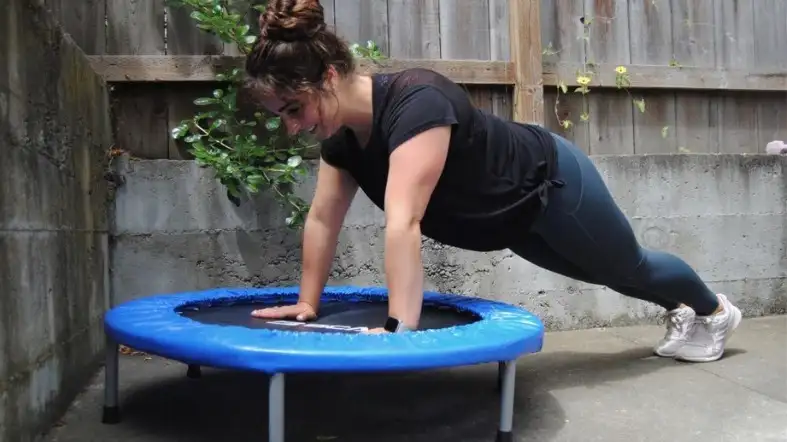
Safety Concerns and Size
There were more than 300,000 trampoline-related injuries in the US in 2022, according to the Consumer Product Safety Commission.
The injuries ranged from bruises, sprains, and cuts to fractures, concussions, and spinal cord injuries.
Here are some examples of safety concerns and features related to trampoline size:
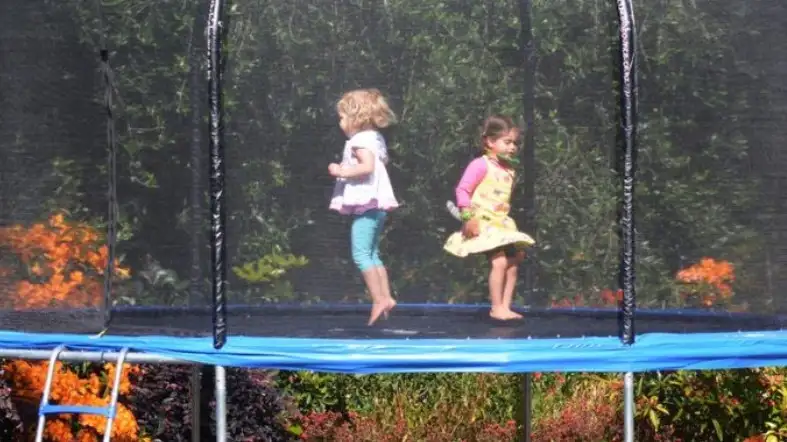
Importance of Safety Nets
Safety nets are one of the most essential safety features for trampolines. Mesh enclosures prevent trampoline users from falling off or landing on the ground.
They can also protect users from hitting metal parts of the trampoline, such as the frame. Larger trampolines (12-25 feet) with higher bounces and more users need safety nets.
As the jumps are higher and more forceful, there is a higher risk of accidents and injuries. Safety nets can reduce these risks by providing a barrier and a cushion.
Maximum Weight Limits
Maximum weight limits are another important safety feature for trampolines. A trampoline can support a maximum amount of weight before breaking or collapsing.
They depend on the size, shape, material, and quality of the trampoline. Trampolines with lower bounces and fewer users should have maximum weight limits.
These trampolines have more chances of breaking or collapsing if they are overloaded or overused.
Trampoline weight limits indicate how many users and how much weight the trampoline can handle. A maximum weight limit is not absolute. It can still vary based on age, size, skill level, and activity.
They can also change over time due to wear and tear or environmental factors. Check the trampoline’s label or manual for the exact weight limit and follow it strictly.
Importance of Quality Spring Covers
Quality spring covers are another important safety feature for trampolines. Covers that go over trampoline springs prevent pinched, scratched and cut users.
They can also prevent users from getting their fingers, toes, hair, or clothing caught in them. Medium-sized trampolines (12-14 feet) with more springs and more users need quality spring covers.
Due to the exposure and tension of the springs, these trampolines are more likely to cause injuries. Quality spring covers can reduce these risks by providing a layer of protection and cushioning.
If it is not maintained regularly or attached properly, a quality spring cover may wear out or fall off. You should always inspect the condition of the spring covers before using them.
Special Features for Trampolines
Here are some examples of special features for trampolines:
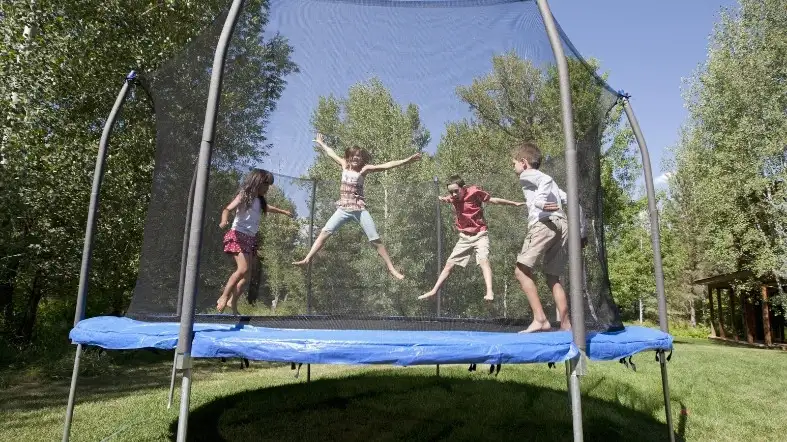
UV-Resistant Material
UV-resistant material is a special feature that can protect your trampoline from sun damage.
It is a type of material that has been treated with a coating or a dye that can block or reflect ultraviolet rays from the sun.
It can prevent your trampoline from fading, cracking, or deteriorating due to sun exposure.
UV-resistant material is especially useful for outdoor trampolines that are exposed to the sun for long periods of time.
It can extend the lifespan and quality of your trampoline. It can also protect your skin and eyes from sunburn and irritation.
Springless Options
Springless options are a special feature that can eliminate the need for springs on your trampoline.
They are alternative mechanisms that can provide bounce and support for your trampoline without using metal coils. They can include rods, bands, or air.
Springless options are safer and quieter than springs. They can prevent injuries and damages caused by the springs, such as pinching, scratching, cutting, or breaking.
They can also reduce the noise and vibration caused by the springs, which can be annoying or disturbing.
Smart Trampolines with Interactive Features
Smart trampolines with interactive features are a special feature that can connect your trampoline to your smartphone or tablet.
They are trampolines that have sensors, cameras, speakers, or screens that can communicate with your device via Bluetooth or Wi-Fi.
They can provide various functions and benefits for your trampoline experience. Smart trampolines with interactive features can make your trampoline more fun and engaging.
They can offer games, challenges, feedback, coaching, music, videos, or social media features that can enhance your enjoyment and motivation on the trampoline.
They can also track your progress and performance on the trampoline and help you improve your skills and fitness.
Cost Implications Based on Size
The value of a trampoline depends on how much you are willing to spend on it.
Initial Costs
The initial costs are the costs that you need to pay when you buy a trampoline. The price includes the trampoline itself, as well as any accessories or extras you may need.
They also include any shipping or delivery fees that may apply. The initial costs of a trampoline depend largely on the size of the trampoline.
The bigger the trampoline, the more expensive it is. Here are some average prices for different trampoline sizes:
| Trampoline Size | Diameter | Average Price |
|---|---|---|
| Mini | 3-5 feet | $50-$100 |
| Small | 8-10 feet | $100-$300 |
| Medium | 12-14 feet | $300-$500 |
| Large | 15-17 feet | $500-$1000 |
Ongoing Maintenance Costs
The ongoing maintenance costs are the costs that you need to pay after you buy a trampoline.
Any worn-out or broken parts or components of the trampoline will need to be repaired, replaced, or upgraded. They also include any energy or water bills that may increase due to using the trampoline.
A trampoline’s ongoing maintenance costs are highly dependent on its quality and durability. The better the quality and durability of the trampoline, the lower the maintenance costs are.
Warranty and Guarantees
Trampolines may or may not come with warranties and guarantees. They are a guarantee or protection offered by the trampoline seller or manufacturer.
They can cover the costs of repairing or replacing the trampoline or any parts or components of it. Warranty and guarantees are not mandatory or universal for trampolines.
They may vary depending on the seller, manufacturer, brand, model, and features of the trampoline. They may also have different terms and conditions that you need to follow to claim them.
FAQs on What Size Trampoline Should I Get
How Big Is a Full-Size Trampoline?
The full size trampoline is 12′ in diameter, which equals about 144 square feet.
What is the Largest Trampoline Size?
The largest trampoline size is a 20ft frame. It can take up to 25 square feet of space and includes all sorts of features.
Should I get a 12 or 14-foot trampoline?
The most popular trampoline size is 12 feet. You might want to consider a 14-foot trampoline if you have a lot of room or expect adults to use the trampoline.
Is a 10 ft trampoline big enough?
A 10 ft trampoline is big enough for most children.
Do I need netting or padding?
Some customers prefer to get some protection from falls by adding extra layers of security like 20 inch square pads over each jumping mat.
How long does my trampoline take to assemble?
Trampolines typically come fully assembled.
Final Thoughts
By now, you should have a clear idea about the trampoline size that fits your needs and space.
Whether it’s a mini trampoline for your youngster or an extra-large model for the whole family, making the right choice ensures endless fun and safety.
So go ahead, pick your ideal trampoline size, and get ready to jump into happiness!

